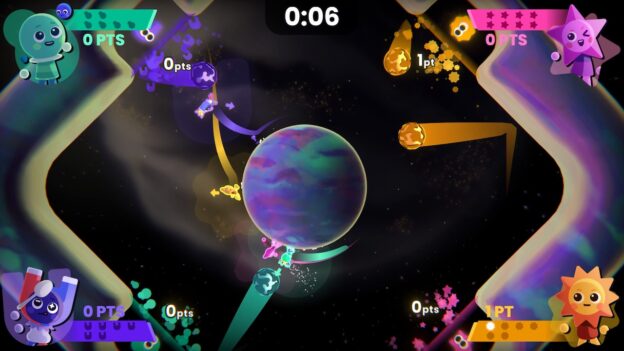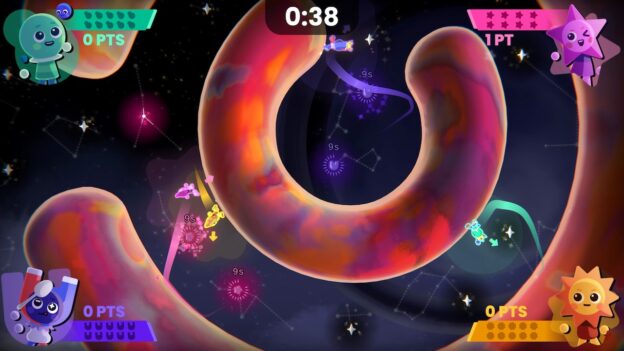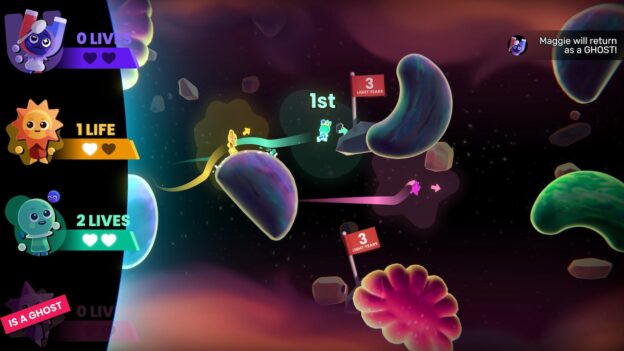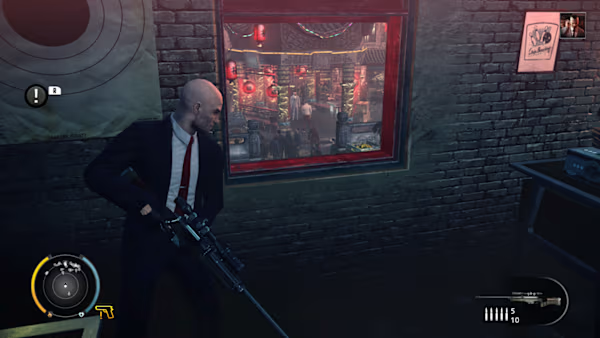Review: Which Way Up: Galaxy Games (Nintendo Switch)

Which Way Up: Galaxy Games is a local party game for the Nintendo Switch. It pits up to four cute characters against each other in gravity-based challenges across floating celestial objects. If you can imagine a 2D version of Mario Galaxy with fast-paced, competitive goals, then you have an idea of how it works. And yes, it’s just as fun as it sounds.
The Galaxy Games of the title is a space-based competition involving celestial beings. These seven adorable creatures – known as Sprites – are each named after a certain cosmic aspect of the universe. For example, Sunny is a sun-like creature, while Luna is a moon-based one. There’s also Prism (based on light), Maggie (magnetism), Spark (stars), and Orbit (solar system). My personal favorite is Sprout, a green creature based on life itself.
Each colorful character performs similarly. What sets them apart is a unique design based on their characteristics. Sunny’s head is round and yellow, while Luna sports a crescent moon. They each feature a unique hue that differentiates them while playing. Despite there not being an advantage to using one character over another, it’s easy to find your favorite based on their design alone.
There are three modes to enjoy in Which Way Up: Practice, Multiplayer, and Single Player. Practice provides a safe space (pun intended) where you freely leap from floating rock to floating rock in peace. No timers. No combat. Just neatly placed instructions to help you figure out your moveset.
Which Way Up’s main premise is its multiplayer aspect, which allows you to compete with up to four local players. You begin by choosing between Casual or Party modes. In Casual mode, you can select from any of the 12 minigames on offer, playing them one at a time at your leisure. Party mode offers more features and structure, all of which are customizable.
For starters, you can choose the number of rounds, number of wins, and difficulty level. The minigames are hosted in a series of cups à la Mario Kart. There are four ready-made cups catered to your skill level, with the option to even create your own custom cup.
The minigames vary immensely, providing many ways to play. The premise is generally to run and jump between floating space objects while achieving a specific goal before anyone else. For example, Hole in One is a golf-like outing that has you attempting to hit a ball into a hole. The catch is that the hole is on a completely different space rock, with gravity, black holes, and other objects standing between you and your goal.
Another outing is Comet Collect, which sees you “kicking” boulders into a goal to score points. It’s a bit like soccer in space. In Star Ring, you have to follow a floating bubble, staying within its boundaries longer than anyone else. There’s a game involving collecting creatures and delivering them to a portal, one involving a hot-potato situation with a timed bomb, and another where you need to blow up other players’ planets. Each is unique and thrillingly fast-paced.
One of my favorites is called Event Horizon. This runner has you moving left to right as you leap from space rock to space rock to avoid the impending doom creeping up behind you. The last one standing, as always, is the winner. It makes me yearn for a full-fledged platformer featuring Sprout in the future.
Despite Which Way Up’s party premise, the single-player mode is more robust than I expected. Here you’ll find six challenges for each of the seven characters. There’s even a short narrative to accompany each challenge, further rounding out the Sprites. These time-based runs award you with medals depending on your speed, with three medals to collect per challenge. It adds longevity to the game, giving solo players something to do when their friends aren’t available. It also makes for good practice! Completionists will enjoy the need to see each medal collected and accounted for.
The most impressive thing about Which Way Up is the gameplay mechanic. Kudos to the team at Turtle Flip Studio for implementing such a silky-smooth, gravity-based jumping system. Running and leaping through space feels simply amazing. It’s a technical feat that has me wondering what the team will do next, and very much looking forward to it. If you need ideas, please see above for my suggestion for a platformer featuring Sprout.
Another standout feature is the user interface. The crisp and colorful aesthetic is coupled with clear instructions that help keep things simple and easy to navigate. I played with a few groups of people ranging from 6 to 18 years old (not including myself, who is much older than either of those years). We all enjoyed the experience and quickly found our favorite minigame and character. There were moments of tense competition, which had us on the edge of our seats. It’s not easy to pull off a successful party title, but it’s all right here in Which Way Up.
Overall, Which Way Up: Galaxy Games is a super-fun and well-designed party title. The dreamy aesthetics and music, coupled with the gravity-based mechanics, help create a unique experience for all players.






